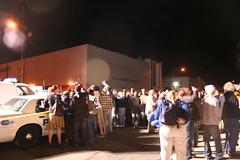Another week at Gallaudet
Frozen Tropics was on the scene Friday night when students were arrested at Gallaudet. More photos here. (I actually got photos two Wednesdays ago, but have been too busy to upload, and now I have computer problems so I can't upload photos right now anyway...)
Quotes in today's Post article, "Deaf Advocate Blasts Arrests," subtitled "Protests Continue Against Incoming Gallaudet President," affirms everything I wrote about this issue last week. The Board is out of touch, and so are the executive officers of the University, including Dr. Jordan and Dr. Fernandes.
See my previous entries:
-- Gallaudet Continued
-- People continue to miss the point about the Gallaudet protests
Can you say American University, Harvard University, Hewlett-Packard and Patricia Dunn, etc.?
There is an incredible disconnect here.
Elise and I were talking about this on Saturday, when we were waiting for people to show up for the Florida Market Tour (apparently not as many of you out there like Korean Food as much as we do, people joined us at the tail end of our breakfast--before that point we figured no one was gonna come, but we had 12 people, with very limited promotion) and I mentioned not only the Deaf President Now! movement in 1988, but when Howard University students rose up to oppose the appointment of Lee Atwater to the board of the university...
From "Howard Board Sets Emergency Meeting on Student Unrest;" Washington Post, 3/15/1989, C1, Robert Thomson
Abstract: The student uprising began March 3, when more than 2,000 demonstrators disrupted the university's convocation ceremony to protest the [Lee Atwater] appointment.
Atwater resigned on March 7 after a confrontation between D.C. police and students. The standoff, in which police pushed in several doors, ended after Mayor Marion Barry entered the administration building to talk with students and University President James E. Cheek asked the officers to withdraw.
Here's the abstract from the Post editorial on the subject ("On Howard's Board, Briefly;" 3/11/1989, A22):
No doubt it was showy of Mr. [Lee Atwater] to go on the Howard board in the first place. His identification with the unexpected drumbeat prominence of the [Willie Horton] issue in the Bush campaign gave him a high and vulnerable personal profile. Howard's huge (70 percent) reliance on federal funding generated charges that he was at least inferentially taking advantage of U.S. government clout to get a post that he could put to partisan GOP purposes. So it isn't exactly surprising that the enterprise turned out the way it did. But you can see Lee Atwater's surprising sudden appointment at Howard as a predictable offense to its student body, or a large part of that student body, anyway, and still hope that black voters, who came close to being taken for granted by Democrats in the last election, would not reject or repudiate out of hand other Republican gestures.
------------------
Newspapers are not about "revolutionary practice." Read the Post editorial about Gallaudet, "Giving Gallaudet a Bad Name," to see what I mean.
Right now I am reading Planning the Capitalist City and Planning in the Public Domain. the latter is about "radical" but not "revolutionary" practice in planning. Revolutionary practice challenges the state. Radical practice focuses on transformation through political means outside of the traditional state structure.
Index Keywords: civic-engagement




0 Comments:
Post a Comment
<< Home